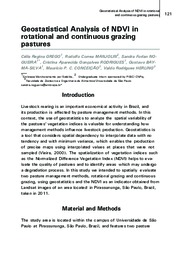Geostatistical Analysis of NDVI in rotational and continuous grazing pastures.
Geostatistical Analysis of NDVI in rotational and continuous grazing pastures.
Author(s): GREGO, C. R.; MANJOLIN, R. C.; NOGUEIRA, S. F.; RODRIGUES, C. A. G.; SILVA, G. B. S. da; CONCEIÇÃO, M. P. C.; HERLING, V. R.
Summary: Livestock rearing is an important economical activity in Brazil, and its production is affected by pasture management methods. In this context, the use of geostatistics to analyze the spatial variability of the pastures? vegetation indices is valuable for understanding how management methods influence livestock production. Geostatistics is a tool that considers spatial dependency to interpolate data with no tendency and with minimum variance, which enables the production of precise maps using interpolated values at places that were not sampled (Vieira, 2000). The spatialization of vegetation indices such as the Normalized Difference Vegetation Index (NDVI) helps to evaluate the quality of pastures and to identify areas which may undergo a degradation process. In this study we intended to spatially evaluate two pasture management methods, rotational grazing and continuous grazing, using geostatistics and the NDVI as an indicator obtained from Landsat images of an area located in Pirassununga, São Paulo, Brazil, taken in 2011.
Publication year: 2016
Types of publication: Paper in annals and proceedings
Unit: Embrapa Territorial
Observation
Some of Embrapa's publications are published as ePub files. To read them, use or download one of the following free software options to your computer or mobile device. Android: Google Play Books; IOS: iBooks; Windows and Linux: Calibre.
Access other publications
Access the Agricultural Research Database (BDPA) to consult Embrapa's full library collection and records.
Visit Embrapa Bookstore to purchase books and other publications sold by Embrapa.

